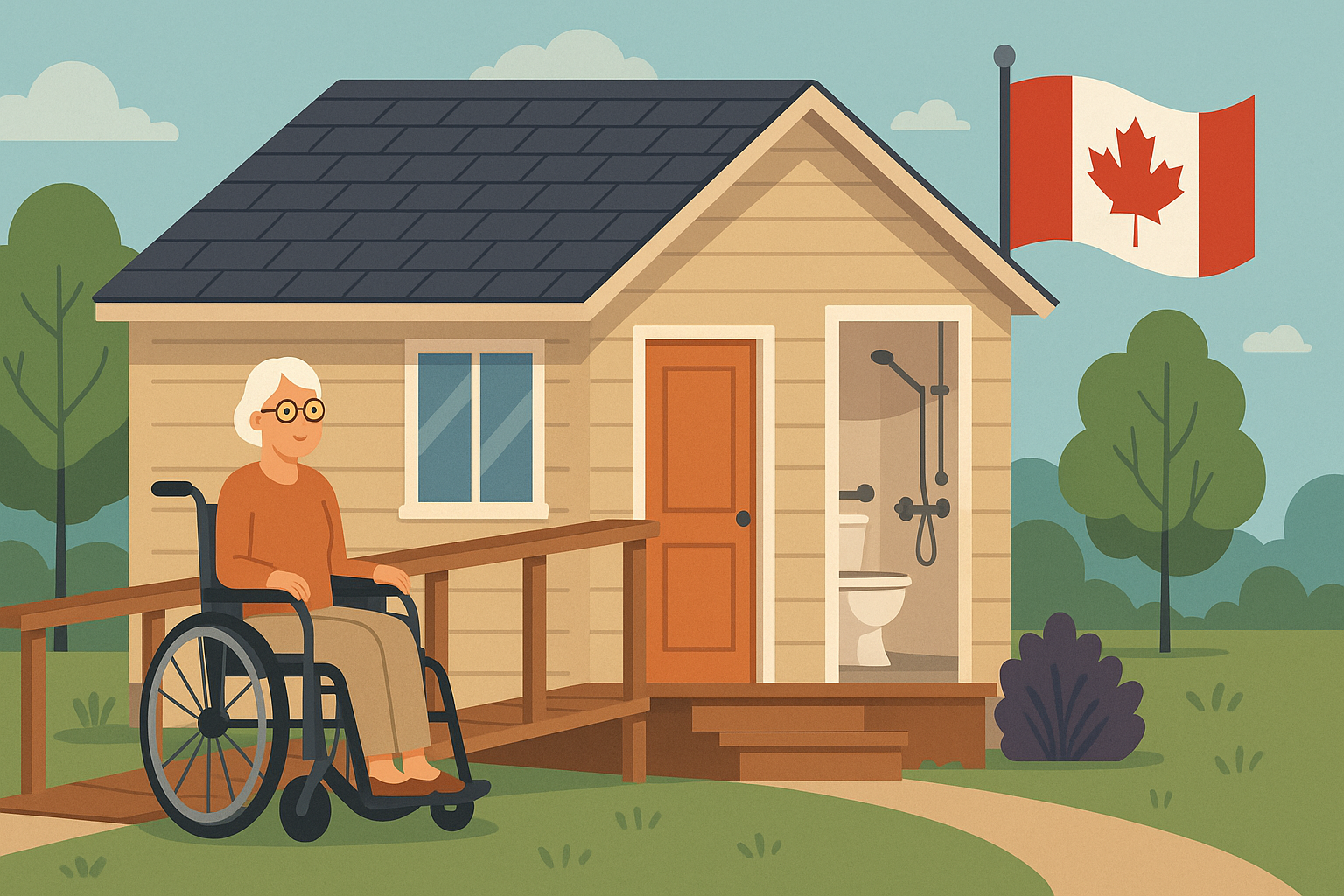
Accessible ADU Design: A Detailed Guide to Aging in Place for Canadian Seniors
Estimated reading time: 7 minutes
Key Takeaways
- *Accessible ADU design* transforms living spaces to ensure safety, comfort, and independence for Canadian seniors.
- This approach embodies universal design and barrier-free living to accommodate mobility and sensory challenges.
- From enhanced entryways and spacious layouts to energy-efficient solutions, every detail contributes to designing ADUs that support aging in place.
- Collaboration with builders and accessibility experts is essential to meet evolving needs over time.
Table of contents
- Understanding Aging in Place and Its Importance
- What is Accessible ADU Design?
- Universal Design Principles in Accessible ADUs
- Barrier-Free Living: Essential Features
- Designing ADUs for Canadian Seniors
- Regulations, Codes, and Incentives
- Collaborating with Builders and Families
- Case Examples: Accessible ADU Design Success Stories
- Conclusion
- Frequently Asked Questions
*Accessory dwelling units (ADUs)* can transform how we support Canadian seniors and families. This detailed guide explores accessible ADU design—an approach that creates safe, comfortable, and empowering living spaces for those wishing to age in place. Whether you are a homeowner, family member, or builder, this post reveals the best practices for creating universally designed, barrier-free environments.
Understanding Aging in Place and Its Importance for Canadian Seniors
Aging in place means seniors can continue living safely and happily in their homes and communities. For Canadian seniors, this concept is more relevant than ever.
Why Aging in Place Matters:
- By 2042, seniors aged 65 and older will make up nearly 25% of Canada’s population. For more on demographic trends and housing needs, see detailed research.
- Living at home promotes:
– Dignity and self-esteem
– Independence and freedom of choice
– Lower reliance on institutional care settings
– Cost-effectiveness for families and society - Studies show that seniors who age in place experience improved well-being, mental health, and a stronger sense of community.
Additional demographic details can be found at this resource.
What is Accessible ADU Design?
Accessible ADU design is about rethinking secondary suites to suit individuals—especially seniors—facing mobility, sensory, or cognitive challenges. It goes beyond basic code compliance to actively remove obstacles to independence.
How Accessible ADU Design Differs:
- Traditional ADUs might include features like steps at entrances and narrow doorways. For more details on standard challenges, refer to this guide.
- Accessible ADUs incorporate:
– No-step (‘zero-threshold’) entries to eliminate tripping hazards
– Wider doorways and hallways for wheelchairs and walkers
– Lever-style handles suited for arthritic hands
– Floorplans that ease turning and access in every room
– Barrier-free transitions with logical layouts
This design approach integrates both universal design and principles of barrier-free living to create truly accessible spaces. Additional details can be found at sources like Adustart and Modern ADU Plans.
Universal Design Principles in Accessible ADUs
Universal design means creating ADUs that are comfortable for everyone, regardless of age or ability. This foundation is critical for ensuring safety and flexibility in homes designed for aging in place.
Key Features of Universal Design in ADUs:
- No-step entries and flush thresholds: Simplify navigation without stairs between spaces.
- Wider doorways and hallways: These allow easy access for wheelchairs or walkers.
- Lever-style handles: Designed to be used with minimal strength, ideal for those with arthritic hands.
- Adjustable-height counters: Counters and shelves that can be lowered or raised for convenience.
- Non-slip, smooth flooring: Ensures safety even when floors are wet.
Other elements include touch-sensitive lighting (smart home tech), contrasting colours, and lower window sills. These principles make ADUs adaptable for everyone from toddlers to seniors, and for those with temporary injuries.
Barrier-Free Living: Essential Features for Accessible ADUs
Barrier-free living eliminates obstacles that can make independent living difficult. Each design choice—from bathroom fixtures to floor transitions—is focused on reducing risks and enhancing daily comfort.
Essential Modifications for Barrier-Free ADUs:
- Accessible Bathrooms: Features such as roll-in showers with grab bars, adjustable showerheads, and toilets at comfort height.
- Seamless Floor Transitions: Eliminating raised thresholds with non-slip, even finishes.
- Optimized Lighting: Bright LED lighting, motion sensors, and easy-to-reach switches in key areas.
- Spacious Layouts: Rooms designed with ample turning radii (typically at least 5 feet wide) for wheelchairs or walkers.
- Reliable Safety Systems: Combination of auditory and visual fire alarms, secure handrails, and the removal of trip hazards.
These features not only support seniors but also cater to those with visual, hearing, or cognitive challenges. For further insights, refer again to resources such as Adustart and Modern ADU Plans.
Designing ADUs for Canadian Seniors: Practical Tips for Accessible ADU Design
Canadian seniors require ADUs that address both accessibility and the local climate. Here are practical tips to create durable, comfortable, and low-maintenance ADUs:
- Choose the Right Materials:
– Opt for non-slip flooring like textured vinyl or slip-resistant tile. (Winter-proof design)
- Prioritize Energy Efficiency:
– High-quality insulation, triple-glazed or double-glazed windows, and well-sealed entry points help maintain comfortable temperatures.
- Install Reliable Heating and Ventilation:
– Consider programmable thermostats, in-floor heating, and efficient ventilation systems.
- Opt for Low-Allergen Finishes:
– Use low-VOC paints and hypoallergenic finishes that are easy to clean.
- Smart Home Technology:
– Integrate automated lighting, motion sensors, and simple security systems. For inspiration, check out smart ADU design ideas.
Regulations, Codes, and Incentives Related to Accessible ADUs in Canada
Building an accessible ADU in Canada requires adherence to national, provincial, and municipal guidelines to ensure safety and legal compliance.
Canadian Building Code Standards include:
- Door Widths: Minimum 32-36 inches for accessible passageways.
- Bathroom Clearances: Adequate space for wheelchair turning and necessary grab bar installations.
- Threshold Heights: No more than 1/2-inch thresholds at entry points.
Local municipalities like Toronto and Vancouver often provide expedited permitting, financial incentives, and consultation services. For more details, visit this guide and Frontier Building Group.
Collaborating with Builders and Families for Accessible ADU Design
Effective accessible ADU design is a collaborative process involving experienced builders, accessibility experts, and families. Early engagement ensures that today’s needs and future requirements are met.
- Engage Experienced Professionals: Select builders familiar with universal design best practices. See tips at Adustart’s guide.
- Involve Accessibility Experts: Occupational therapists and consultants can offer valuable insights on everyday challenges.
- Maintain Open Communication: Discuss foreseeable needs and capture preferences for features such as bath rails, counter heights, and emergency systems.
Case Examples: Accessible ADU Design Success Stories in Canada
Across Canada, real-world examples illustrate the positive impact of accessible ADU design.
- Ontario Garden Suites: These feature walk-in, step-free entries, roll-in showers with grab bars, and open-plan kitchens with adjustable counters.
- Family Testimonial: One family built a backyard suite for elderly parents, noting,
“Our parents enjoy their independence while we are close enough to help. The zero-threshold shower and smart lighting have made all the difference.”
- Community Impact: Reduced time in care facilities, lower monthly costs, and enhanced social connections are just a few benefits.
Conclusion: Investing in Accessible ADU Design for Canadian Seniors
Integrating accessible ADU design into homes is key to supporting aging in place for Canadian seniors. By removing physical and social obstacles through universal design and barrier-free living, ADUs become flexible and future-proof spaces that enhance safety, independence, and family connectivity.
Moving forward, Canadian homeowners, families, and builders should:
- Consult with accessibility experts and experienced builders.
- Plan early to incorporate universal, barrier-free features.
- Anticipate both today’s and tomorrow’s accessibility needs.
Invest in accessible ADU design today for safe, inclusive, and independent living spaces. For further information, explore resources such as My Own Cottage, Frontier Building Group, Adustart, Modern ADU Plans, and Adustart’s builder guide.
Frequently Asked Questions
- What is the primary benefit of accessible ADU design?
- Accessible ADU design creates living spaces that are safe, easy to navigate, and adaptable for seniors and individuals with mobility challenges, promoting independent living.
- How does universal design improve ADU functionality?
- Universal design ensures that every space is usable by everyone—regardless of age or ability—by integrating features like no-step entries, wider doorways, and adaptable fixtures.
- Are there financial incentives for building accessible ADUs in Canada?
- Yes, many Canadian municipalities offer expedited permits and financial rebates or grants to encourage the creation of accessible secondary suites.

Leave a Reply